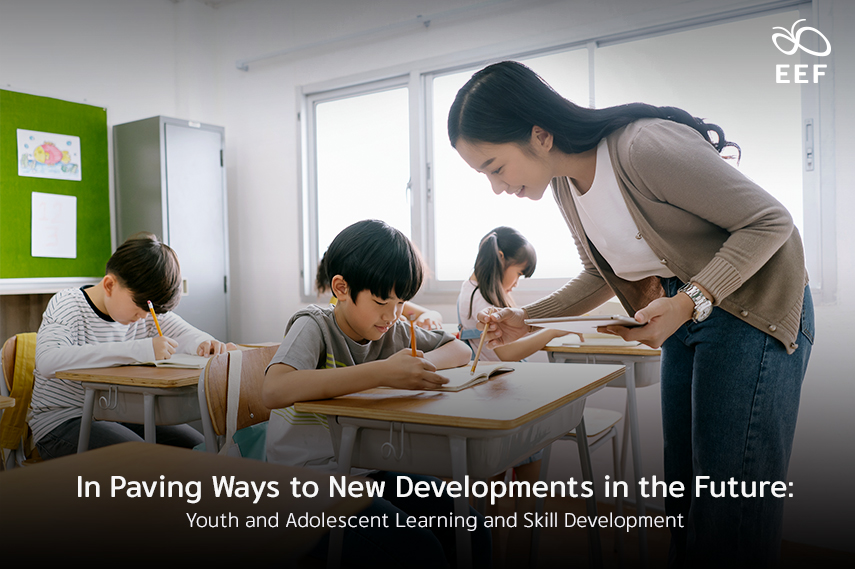
The Asia-Pacific region has the largest proportion of youths and adolescents in the world. They are in a transitional period from childhood to adulthood, from school to work. And with transition comes a new set of challenges, even more so in the 21st century when ones are required to have more skills than ever, not just for their employees, but also for the sustainable development of their societies and countries. However, it is also this region that has the highest rate of falling out of the educational system, not to mention the COVID-19-induced increased unemployment rate. Youth and adolescents need to be brought back to school to acquire skills for the future.
In doing so, it is necessary to take into account new changes brought on by the pandemic, such as changing work nature and skill requirements. In response, educational institutions have modified their curricula to be more flexible, by either reducing the number of non-elective courses or re-designating some previously non-electives as electives. Besides, to fulfill the demands of the labor market, they have collaborated with the private sector to develop new specialized skill courses where theoretical teaching runs in parallel with practical work.
In light of the shifting social and economic landscape post-COVID-19, Mr. Julien Magnat, skills and employment specialist at the Asia and Pacific regional office of the International Labor Organization (ILO) has proposed the following 3D principles for adjusting the educational systems to meet youths’ and adolescents’ needs:
1) Digital Transformation — Given the new labor market conditions, particularly during and after the pandemic, there is a growing demand for digital job skills, be it in the field of information technology or database technology including AI and Blockchain. These are new skills, that conventional educational systems have never widely taught to youths and adolescents. Therefore, many curricula must be developed to address such demand.
2) Decarbonization — As environmental impact awareness has become integral to technological development, it would be unacceptable for current technologies to continue to develop without incorporating Greentech. Therefore, new courses must focus not only on technological development but also on environmental impact.
3) Demographic — Due to the slowdown in employment during the COVID-19 pandemic, youth, and adolescent unemployment has increased exponentially in such a short period. Therefore, curricula are under pressure to be short-term and job-specific, for youths and adolescents to return to the educational system and get out to work as soon as possible.
The statement made by Julien Magnat on the 3D principles coincides with the statement made by Ms. Meekyung Shin, an education expert at the Asian Development Bank on South Korea’s educational management approach that can effectively prevent the impact of COVID-19 from further affecting its education. The approach can be divided into four levels according to the levels of education as follows:
1) Higher Education will focus on digital transformation and green transformation — which is in line with the approach suggested by Dr. Magnat —, with an emphasis being placed on courses on mathematics, science, and technology. In doing so, new teaching methods will be employed; irrelevant content will be removed, and there will be more courses that are developed based on learners’ initiatives so that they are up-to-date and time-relevant;
2) Vocational Education will focus on AI among many other state-of-the-art technologies. In doing so, courses on the latest technologies will be constantly added to equip workforces with the knowledge and skills necessary to meet the market demands; and there will be courses developed in collaboration with private sectors that guarantee positions after graduation;
3) High School Education will focus on flexibility, freedom, and openness to allow learners to fully explore who they are before selecting the best course of study;
4) Junior High School Education will focus on creativity and inspiration to encourage learners to be enthusiastic, dare to think and dream.

With the transition from childhood to adulthood comes a new set of challenges, even more so in the 21st century when youths and adolescents are required to have more skills than ever, not just for their employees, but also for the sustainable development of their societies and countries. However, those in the Asia-Pacific region are now facing the highest rate of falling out of the educational system, not to mention the COVID-19-induced increased unemployment rate. It is urgently needed that they are brought back to school to acquire skills for the future.
Source: 2ND ASIA-PACIFIC REGIONAL EDUCATION MINISTER’S CONFERENCE (APREMC II) – Session 8

